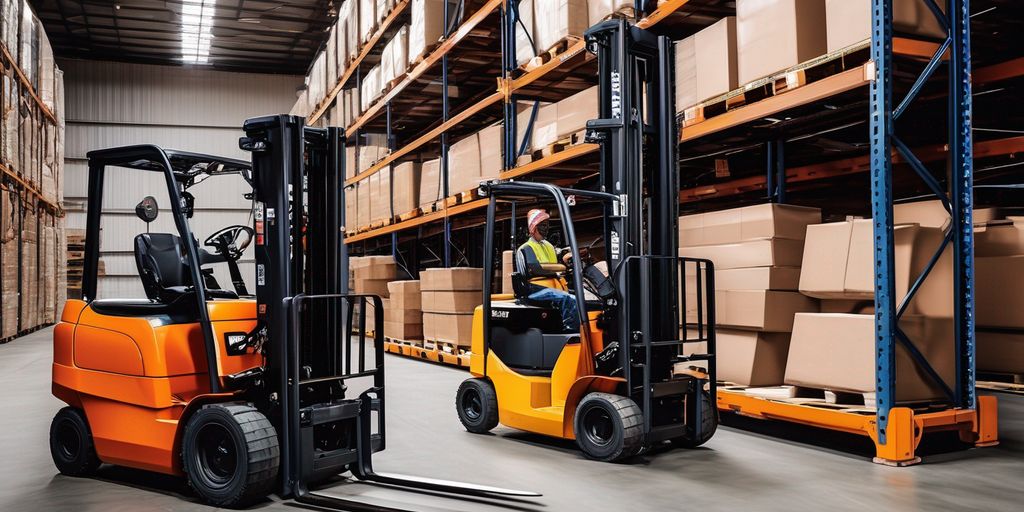When it comes to purchasing a forklift for your business, it's not just about picking any model off the shelf. This decision requires a thorough understanding of your business's specific needs and operational objectives. In this article, we'll explore 10 key considerations that will guide you in making a well-informed choice, ensuring that the forklift you select enhances efficiency, safety, and overall productivity in your operations.
Key Takeaways
- Assess your overall business requirements to ensure the forklift meets your operational needs.
- Choose the right forklift by considering factors like size, capacity, and the type of materials it will handle.
- Understand the total cost of ownership, including maintenance, fuel, and potential repairs.
- Consider the safety features of the forklift, such as stability, visibility, and emergency stop systems.
- Ensure compliance with licensing and training requirements for forklift operators.
1. Assess Your Overall Business Requirements

Before making a decision on purchasing a forklift, it is crucial to assess your overall business requirements. This involves understanding the specific needs of your operations and how a forklift fits into your current and future business plans. Start by evaluating the following key areas:
- Current equipment usage: Review what machinery and equipment are currently in use and their efficiency.
- Warehouse space and layout: Consider the size and layout of your warehouse to determine the type of forklift that would be most effective.
- Operational objectives: Define your short-term and long-term business goals to align your equipment needs accordingly.
- Throughput requirements: Analyze the volume of work your business handles to select a forklift with the appropriate capacity.
It is essential to accurately assess the maximum weight of items that your business regularly handles to choose the right forklift.
By carefully considering these factors, you can ensure that the forklift you choose will be a cost-effective and valuable addition to your business operations.
2. Choosing the Right Forklift

Choosing the right forklift is crucial for enhancing operational efficiency and ensuring safety in your business environment. It involves considering various factors such as load capacity, fuel type, and maneuverability. Brands like Toyota, Linde, and Crown offer unique advantages, which should be carefully evaluated against your specific needs.
It's essential to match the forklift's capabilities with the demands of your operational environment to avoid costly mismatches and operational inefficiencies.
Here are some key considerations:
- Assess the primary environment where the forklift will be used (indoor vs. outdoor).
- Consider the typical load types and weights that the forklift will handle.
- Evaluate different fuel options (electric, diesel, gas) based on availability and cost implications.
- Look into the ergonomics and ease of use, as these can significantly impact operator fatigue and productivity.
3. Lifting Capacity

When selecting a forklift, assessing the lifting capacity is crucial as it directly impacts both safety and operational efficiency. The capacity of a forklift to lift and transport loads should align with your business's regular needs. It's important to consider not just the maximum weight but also the height to which the load can be lifted.
Ensure the forklift you choose can handle the maximum weight your business operations require on a regular basis.
Forklifts come in various capacities, typically measured in tons. For instance, electric forklifts might range from handling 1.5 to 3.5 tons, while diesel-powered models could lift up to 16 tons. This variety allows businesses to select a forklift that best fits their specific needs, from light warehouse tasks to heavy-duty industrial operations.
Key Considerations:
- Load stability before lifting
- Maximum weight and height capabilities
- Suitability for intended industrial applications
4. Safety Features

When selecting a forklift, safety should be a top priority. Key features to consider include stability, visibility from the cab, and the presence of safety enclosures. Effective braking systems, warning systems, and speed control are essential to prevent accidents. Additionally, operator restraints and emergency stop systems provide critical safety measures in case of an emergency.
Important Safety Enhancements
- Forklift Speed Limiter: Limits the maximum speed to ensure safe operation.
- Fork View Camera System: Enhances visibility, reducing the risk of accidents.
Ensuring that these safety features are in place can significantly reduce workplace accidents and improve overall safety.
5. Total Cost of Ownership

Understanding the total cost of ownership is crucial when considering a forklift for your business. This includes not only the purchase price but also long-term costs such as maintenance, fuel, and potential downtime. Here are some key factors to consider:
- Initial Purchase Price: The upfront cost can vary significantly based on the model and specifications.
- Maintenance and Repairs: Regular maintenance is essential to keep the forklift in good working condition. The costs can accumulate, especially as the vehicle ages.
- Fuel or Power Costs: Depending on whether the forklift is powered by diesel, gas, or electricity, the running costs will differ.
- Resale Value: Consider the potential resale value of the forklift, as this can offset some of the initial investment costs.
It's important to calculate these expenses over the lifespan of the forklift to get a true sense of what the total cost of ownership will be. Using the total cost of ownership as a guiding principle can help avoid unforeseen financial strain.
6. Power Type

Choosing the right power type for your forklift is essential for meeting your operational needs efficiently. Whether it's electric, diesel, or LPG, each power source has its own set of advantages and considerations. Electric forklifts are praised for their efficiency and low emissions, making them ideal for indoor use and environmentally conscious operations. Diesel and LPG units, on the other hand, are often favored for their robust performance in outdoor settings.
It's crucial to align the power type with your specific business activities, environmental policies, and the physical layout of your operations.
Here are the common power types and their typical applications:
- Electric: Best for indoor use due to zero emissions.
- Diesel: Ideal for outdoor and heavy-duty tasks.
- LPG: A versatile option suitable for both indoor and outdoor use, but with some emissions.
Selecting the appropriate power type is a crucial decision that can significantly impact your operational efficiency and compliance with emissions regulations.
7. Product Utilisation

Understanding how frequently and intensively a forklift will be used in your operations is crucial to selecting the right model. High utilisation of forklifts, especially across multiple shifts, necessitates features that enhance durability and operator comfort. Considerations include:
- Ergonomic design: To reduce operator fatigue and increase productivity, opt for forklifts with comfortable seating and intuitive controls.
- Maintenance needs: Heavier usage demands more robust maintenance plans to ensure longevity and efficiency.
- Type of operations: The nature of the tasks—whether indoor, outdoor, or requiring precise maneuverability—also dictates the type of forklift suitable for your business.
By aligning the forklift's features with your business's operational demands, you can maximize both productivity and equipment lifespan.
8. Achieving Internal Buy-In

Achieving internal buy-in is crucial when considering the acquisition of a new forklift. It involves ensuring all stakeholders understand the benefits and the strategic importance of the investment. Here are some steps to facilitate this process:
- Present a clear business case: Outline the operational and financial benefits, such as improved efficiency and potential cost savings.
- Engage key stakeholders early: Include input from various departments to foster a sense of ownership and address any concerns upfront.
- Demonstrate ROI: Use data and case studies to show how the forklift will meet business needs and contribute to the bottom line.
- Facilitate open discussions: Encourage feedback and open dialogue to address doubts and build consensus.
By taking these steps, you can ensure that the decision to invest in a new forklift is well-supported across your organization, leading to smoother implementation and better utilization of the equipment.
9. Licensing and Driver Requirements

When purchasing a forklift, it's crucial to understand the licensing and driver requirements to ensure compliance with regulations and maintain operational safety. Every operator must be properly certified, and depending on your location, specific licenses might be required. Here are some steps to ensure you meet all necessary requirements:
- Verify the type of certification needed for your operators based on the forklift model and usage.
- Determine if a special driving license is required beyond a standard driver’s license.
- Conduct regular audits to ensure all operators have up-to-date training and certifications.
- Consult with local authorities or a legal advisor to confirm compliance with local and national laws.
Regularly updating training and certifications can significantly reduce the risk of accidents and increase efficiency in operations.
10. Future-Proofing Operations

When considering the future-proofing of your forklift operations, it's crucial to evaluate not only the current needs but also anticipate future demands and challenges. Ensure your forklift choices are adaptable to changes in technology, operational scale, and business goals. Consider the following aspects to maintain relevance and efficiency:
- Technological advancements: Stay updated with the latest innovations that can enhance efficiency and safety.
- Scalability: Choose equipment that can grow with your business needs, whether that involves higher capacities or additional features.
- Maintenance and serviceability: Regular maintenance and easy serviceability extend the lifespan of forklifts and maximize their trade-in value.
- Environmental considerations: Opt for forklifts with lower emissions or better energy efficiency to meet future environmental regulations.
By planning ahead and choosing wisely, you can safeguard your operations against becoming outdated too quickly, ensuring a better return on investment and operational continuity.
Conclusion
In conclusion, purchasing a forklift for your business involves a comprehensive evaluation of various factors. From understanding your business requirements and achieving internal buy-in to assessing operational objectives and ensuring compliance with licensing requirements, each step is crucial for making an informed decision. This guide has provided you with essential considerations to navigate the complexities of choosing the right forklift. Armed with this knowledge, you are better equipped to select a forklift that aligns with your business needs, enhances operational efficiency, and ensures safety and cost-effectiveness. Remember, the right forklift can significantly impact your business's productivity and bottom line, so take the time to make a well-considered choice.
Frequently Asked Questions
What factors should I consider before buying a forklift?
Consider your overall business requirements, the equipment you currently use, your warehouse space, and truck availability. Assessing these factors helps ensure the forklift meets your operational needs.
How do I achieve internal buy-in when purchasing a forklift?
Assess your business goals and objectives, identify the best solutions, and communicate effectively with your team to ensure everyone understands the benefits and efficiency gains from the new forklift.
What are the key safety features to look for in a forklift?
Prioritize safety by considering factors like stability, cab visibility, safety enclosures, braking systems, warning systems, speed control, restraints, and emergency stop systems.
How can I determine the right lifting capacity for my forklift?
Assess the lifting capabilities at various heights to ensure the forklift meets your business demands and enhances safety and utilisation.
What should I know about the total cost of ownership for a forklift?
Consider factors such as initial purchase price, maintenance costs, operational expenses, and potential resale value to understand the total cost of ownership.
What type of power should I consider for my forklift?
Choose the power type based on your usage patterns, operational environment, and energy efficiency goals. Options include electric, diesel, or gas-powered forklifts.




Leave a comment
This site is protected by hCaptcha and the hCaptcha Privacy Policy and Terms of Service apply.